Exploring Behaviour Strategies in Children's Development
VerifiedAdded on 2023/06/08
|17
|6900
|246
Report
AI Summary
This report provides a comprehensive analysis of behavior strategies and their impact on child development, addressing critical aspects such as environmental influences, effective parenting practices, and the recognition of developmental changes. It examines the internal and external factors affecting children's mental health and discusses disruptive behaviors versus behaviors of concern, highlighting the importance of understanding and managing children's emotional responses. The report also explores how different human emotions are communicated through behavior and emphasizes the use of redirection strategies to promote positive behavior and defuse challenging situations. Furthermore, it distinguishes between the behavioral management needs of a 9-year-old and a 4-year-old, offering tailored strategies for each age group. The report concludes by suggesting routines and positive phrasing to encourage desirable behaviors, as well as techniques for calming and redirecting children in misbehavior situations.

Behaviour Strategies
Paraphrase This Document
Need a fresh take? Get an instant paraphrase of this document with our AI Paraphraser

Table of Content.
INTRODUCTION...........................................................................................................................3
MAIN BODY...................................................................................................................................3
Assessment-1...................................................................................................................................3
QUESTION 1A............................................................................................................................3
QUESTION 2A...........................................................................................................................3
QUESTION 3 A...........................................................................................................................4
QUESTION 4A............................................................................................................................4
QUESTION 5A...........................................................................................................................5
QUESTION 6A............................................................................................................................5
QUESTION 7A...........................................................................................................................6
QUESTION 7B...........................................................................................................................6
QUESTION 7B............................................................................................................................6
QUESTION 7C............................................................................................................................7
QUESTION 8A............................................................................................................................7
QUESTION 8B...........................................................................................................................8
QUESTION 9A...........................................................................................................................8
QUESTION 11A..........................................................................................................................9
QUESTION 12A ......................................................................................................................10
QUESTION 12B........................................................................................................................10
Assessment-2 ................................................................................................................................11
QUESTION 1 A.........................................................................................................................11
QUESTION 2 A .......................................................................................................................11
QUESTION 3A..........................................................................................................................12
QUESTION 4A..........................................................................................................................12
Question 5A...............................................................................................................................13
Question 6A...............................................................................................................................13
Question 7A...............................................................................................................................14
Question 8A...............................................................................................................................15
Reference ......................................................................................................................................15
INTRODUCTION...........................................................................................................................3
MAIN BODY...................................................................................................................................3
Assessment-1...................................................................................................................................3
QUESTION 1A............................................................................................................................3
QUESTION 2A...........................................................................................................................3
QUESTION 3 A...........................................................................................................................4
QUESTION 4A............................................................................................................................4
QUESTION 5A...........................................................................................................................5
QUESTION 6A............................................................................................................................5
QUESTION 7A...........................................................................................................................6
QUESTION 7B...........................................................................................................................6
QUESTION 7B............................................................................................................................6
QUESTION 7C............................................................................................................................7
QUESTION 8A............................................................................................................................7
QUESTION 8B...........................................................................................................................8
QUESTION 9A...........................................................................................................................8
QUESTION 11A..........................................................................................................................9
QUESTION 12A ......................................................................................................................10
QUESTION 12B........................................................................................................................10
Assessment-2 ................................................................................................................................11
QUESTION 1 A.........................................................................................................................11
QUESTION 2 A .......................................................................................................................11
QUESTION 3A..........................................................................................................................12
QUESTION 4A..........................................................................................................................12
Question 5A...............................................................................................................................13
Question 6A...............................................................................................................................13
Question 7A...............................................................................................................................14
Question 8A...............................................................................................................................15
Reference ......................................................................................................................................15
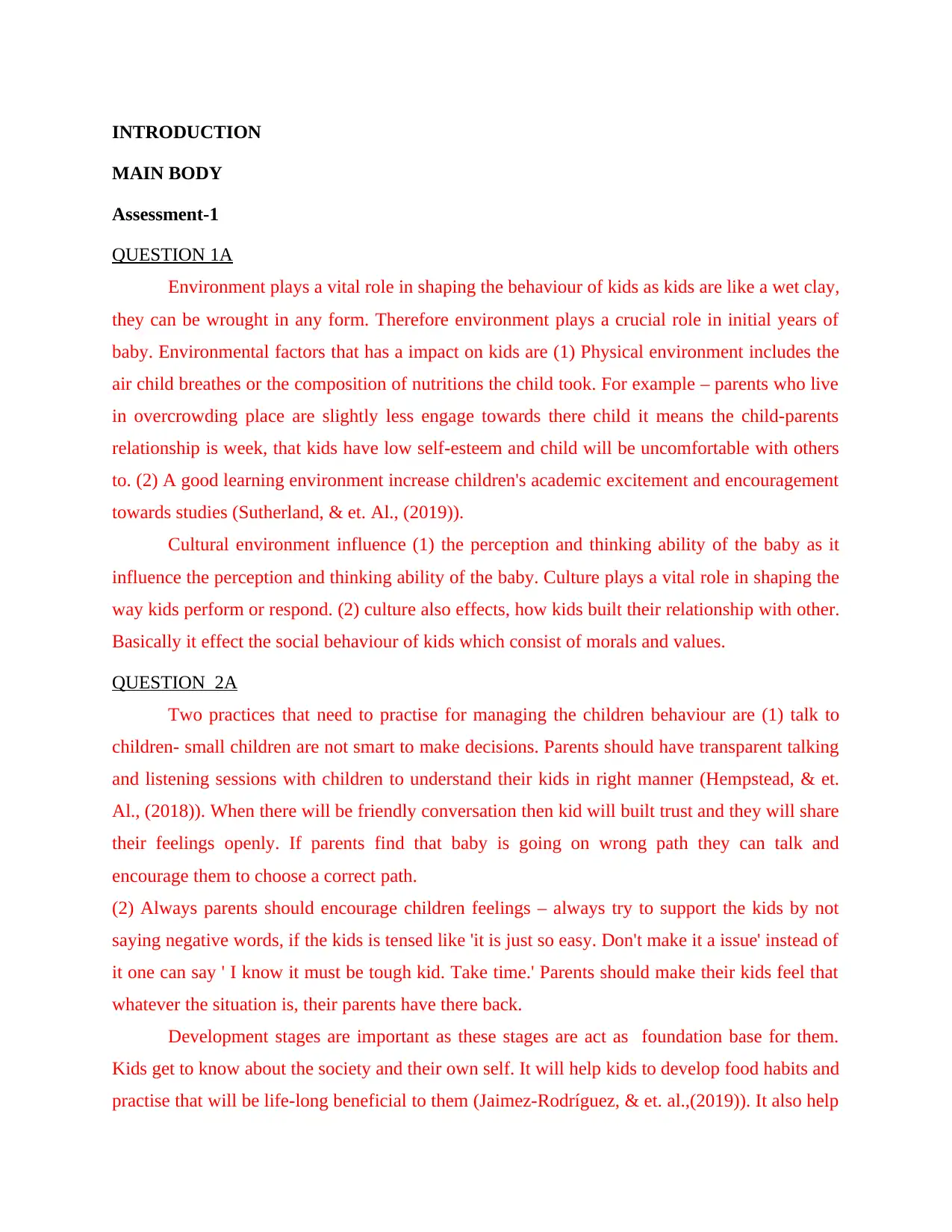
INTRODUCTION
MAIN BODY
Assessment-1
QUESTION 1A
Environment plays a vital role in shaping the behaviour of kids as kids are like a wet clay,
they can be wrought in any form. Therefore environment plays a crucial role in initial years of
baby. Environmental factors that has a impact on kids are (1) Physical environment includes the
air child breathes or the composition of nutritions the child took. For example – parents who live
in overcrowding place are slightly less engage towards there child it means the child-parents
relationship is week, that kids have low self-esteem and child will be uncomfortable with others
to. (2) A good learning environment increase children's academic excitement and encouragement
towards studies (Sutherland, & et. Al., (2019)).
Cultural environment influence (1) the perception and thinking ability of the baby as it
influence the perception and thinking ability of the baby. Culture plays a vital role in shaping the
way kids perform or respond. (2) culture also effects, how kids built their relationship with other.
Basically it effect the social behaviour of kids which consist of morals and values.
QUESTION 2A
Two practices that need to practise for managing the children behaviour are (1) talk to
children- small children are not smart to make decisions. Parents should have transparent talking
and listening sessions with children to understand their kids in right manner (Hempstead, & et.
Al., (2018)). When there will be friendly conversation then kid will built trust and they will share
their feelings openly. If parents find that baby is going on wrong path they can talk and
encourage them to choose a correct path.
(2) Always parents should encourage children feelings – always try to support the kids by not
saying negative words, if the kids is tensed like 'it is just so easy. Don't make it a issue' instead of
it one can say ' I know it must be tough kid. Take time.' Parents should make their kids feel that
whatever the situation is, their parents have there back.
Development stages are important as these stages are act as foundation base for them.
Kids get to know about the society and their own self. It will help kids to develop food habits and
practise that will be life-long beneficial to them (Jaimez-Rodríguez, & et. al.,(2019)). It also help
MAIN BODY
Assessment-1
QUESTION 1A
Environment plays a vital role in shaping the behaviour of kids as kids are like a wet clay,
they can be wrought in any form. Therefore environment plays a crucial role in initial years of
baby. Environmental factors that has a impact on kids are (1) Physical environment includes the
air child breathes or the composition of nutritions the child took. For example – parents who live
in overcrowding place are slightly less engage towards there child it means the child-parents
relationship is week, that kids have low self-esteem and child will be uncomfortable with others
to. (2) A good learning environment increase children's academic excitement and encouragement
towards studies (Sutherland, & et. Al., (2019)).
Cultural environment influence (1) the perception and thinking ability of the baby as it
influence the perception and thinking ability of the baby. Culture plays a vital role in shaping the
way kids perform or respond. (2) culture also effects, how kids built their relationship with other.
Basically it effect the social behaviour of kids which consist of morals and values.
QUESTION 2A
Two practices that need to practise for managing the children behaviour are (1) talk to
children- small children are not smart to make decisions. Parents should have transparent talking
and listening sessions with children to understand their kids in right manner (Hempstead, & et.
Al., (2018)). When there will be friendly conversation then kid will built trust and they will share
their feelings openly. If parents find that baby is going on wrong path they can talk and
encourage them to choose a correct path.
(2) Always parents should encourage children feelings – always try to support the kids by not
saying negative words, if the kids is tensed like 'it is just so easy. Don't make it a issue' instead of
it one can say ' I know it must be tough kid. Take time.' Parents should make their kids feel that
whatever the situation is, their parents have there back.
Development stages are important as these stages are act as foundation base for them.
Kids get to know about the society and their own self. It will help kids to develop food habits and
practise that will be life-long beneficial to them (Jaimez-Rodríguez, & et. al.,(2019)). It also help
⊘ This is a preview!⊘
Do you want full access?
Subscribe today to unlock all pages.

Trusted by 1+ million students worldwide
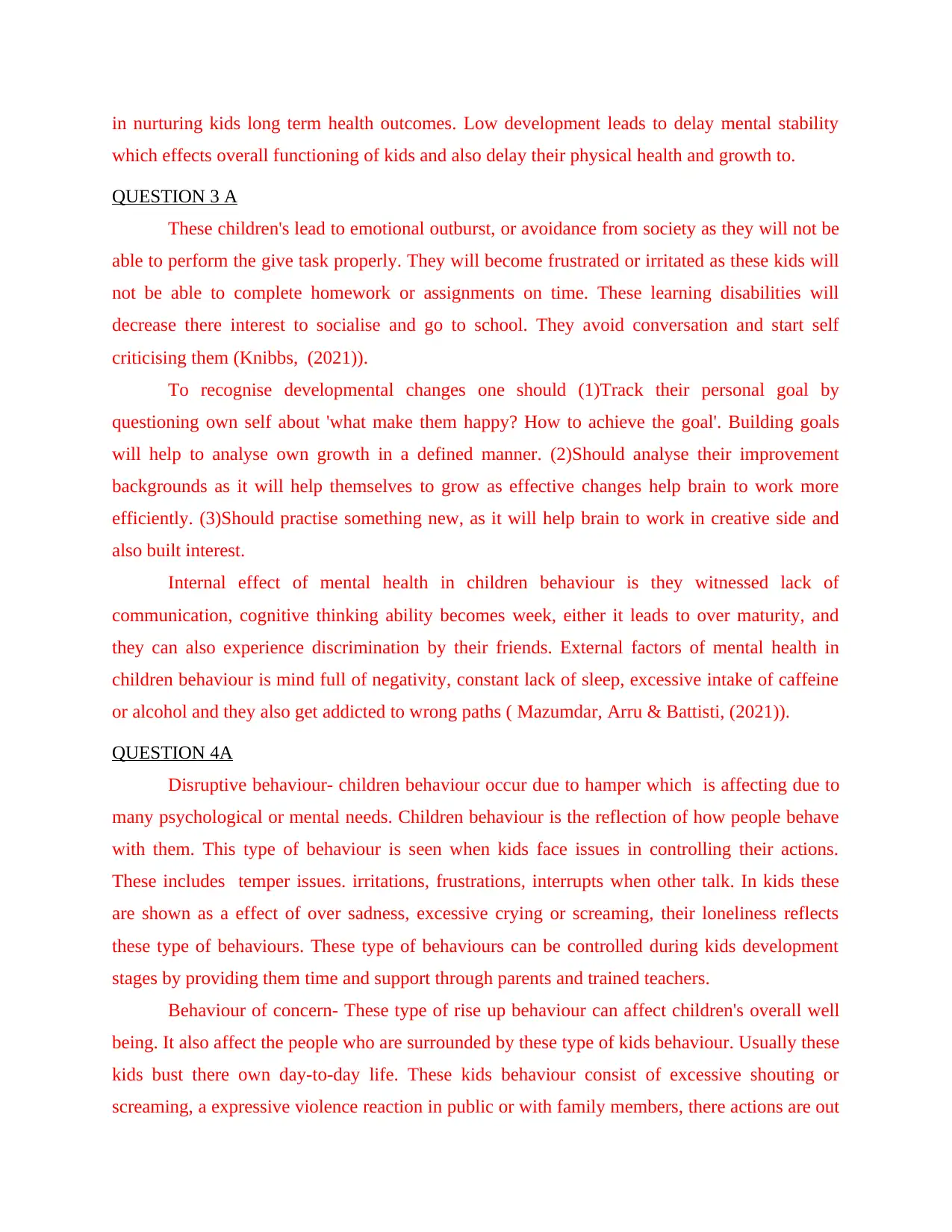
in nurturing kids long term health outcomes. Low development leads to delay mental stability
which effects overall functioning of kids and also delay their physical health and growth to.
QUESTION 3 A
These children's lead to emotional outburst, or avoidance from society as they will not be
able to perform the give task properly. They will become frustrated or irritated as these kids will
not be able to complete homework or assignments on time. These learning disabilities will
decrease there interest to socialise and go to school. They avoid conversation and start self
criticising them (Knibbs, (2021)).
To recognise developmental changes one should (1)Track their personal goal by
questioning own self about 'what make them happy? How to achieve the goal'. Building goals
will help to analyse own growth in a defined manner. (2)Should analyse their improvement
backgrounds as it will help themselves to grow as effective changes help brain to work more
efficiently. (3)Should practise something new, as it will help brain to work in creative side and
also built interest.
Internal effect of mental health in children behaviour is they witnessed lack of
communication, cognitive thinking ability becomes week, either it leads to over maturity, and
they can also experience discrimination by their friends. External factors of mental health in
children behaviour is mind full of negativity, constant lack of sleep, excessive intake of caffeine
or alcohol and they also get addicted to wrong paths ( Mazumdar, Arru & Battisti, (2021)).
QUESTION 4A
Disruptive behaviour- children behaviour occur due to hamper which is affecting due to
many psychological or mental needs. Children behaviour is the reflection of how people behave
with them. This type of behaviour is seen when kids face issues in controlling their actions.
These includes temper issues. irritations, frustrations, interrupts when other talk. In kids these
are shown as a effect of over sadness, excessive crying or screaming, their loneliness reflects
these type of behaviours. These type of behaviours can be controlled during kids development
stages by providing them time and support through parents and trained teachers.
Behaviour of concern- These type of rise up behaviour can affect children's overall well
being. It also affect the people who are surrounded by these type of kids behaviour. Usually these
kids bust there own day-to-day life. These kids behaviour consist of excessive shouting or
screaming, a expressive violence reaction in public or with family members, there actions are out
which effects overall functioning of kids and also delay their physical health and growth to.
QUESTION 3 A
These children's lead to emotional outburst, or avoidance from society as they will not be
able to perform the give task properly. They will become frustrated or irritated as these kids will
not be able to complete homework or assignments on time. These learning disabilities will
decrease there interest to socialise and go to school. They avoid conversation and start self
criticising them (Knibbs, (2021)).
To recognise developmental changes one should (1)Track their personal goal by
questioning own self about 'what make them happy? How to achieve the goal'. Building goals
will help to analyse own growth in a defined manner. (2)Should analyse their improvement
backgrounds as it will help themselves to grow as effective changes help brain to work more
efficiently. (3)Should practise something new, as it will help brain to work in creative side and
also built interest.
Internal effect of mental health in children behaviour is they witnessed lack of
communication, cognitive thinking ability becomes week, either it leads to over maturity, and
they can also experience discrimination by their friends. External factors of mental health in
children behaviour is mind full of negativity, constant lack of sleep, excessive intake of caffeine
or alcohol and they also get addicted to wrong paths ( Mazumdar, Arru & Battisti, (2021)).
QUESTION 4A
Disruptive behaviour- children behaviour occur due to hamper which is affecting due to
many psychological or mental needs. Children behaviour is the reflection of how people behave
with them. This type of behaviour is seen when kids face issues in controlling their actions.
These includes temper issues. irritations, frustrations, interrupts when other talk. In kids these
are shown as a effect of over sadness, excessive crying or screaming, their loneliness reflects
these type of behaviours. These type of behaviours can be controlled during kids development
stages by providing them time and support through parents and trained teachers.
Behaviour of concern- These type of rise up behaviour can affect children's overall well
being. It also affect the people who are surrounded by these type of kids behaviour. Usually these
kids bust there own day-to-day life. These kids behaviour consist of excessive shouting or
screaming, a expressive violence reaction in public or with family members, there actions are out
Paraphrase This Document
Need a fresh take? Get an instant paraphrase of this document with our AI Paraphraser
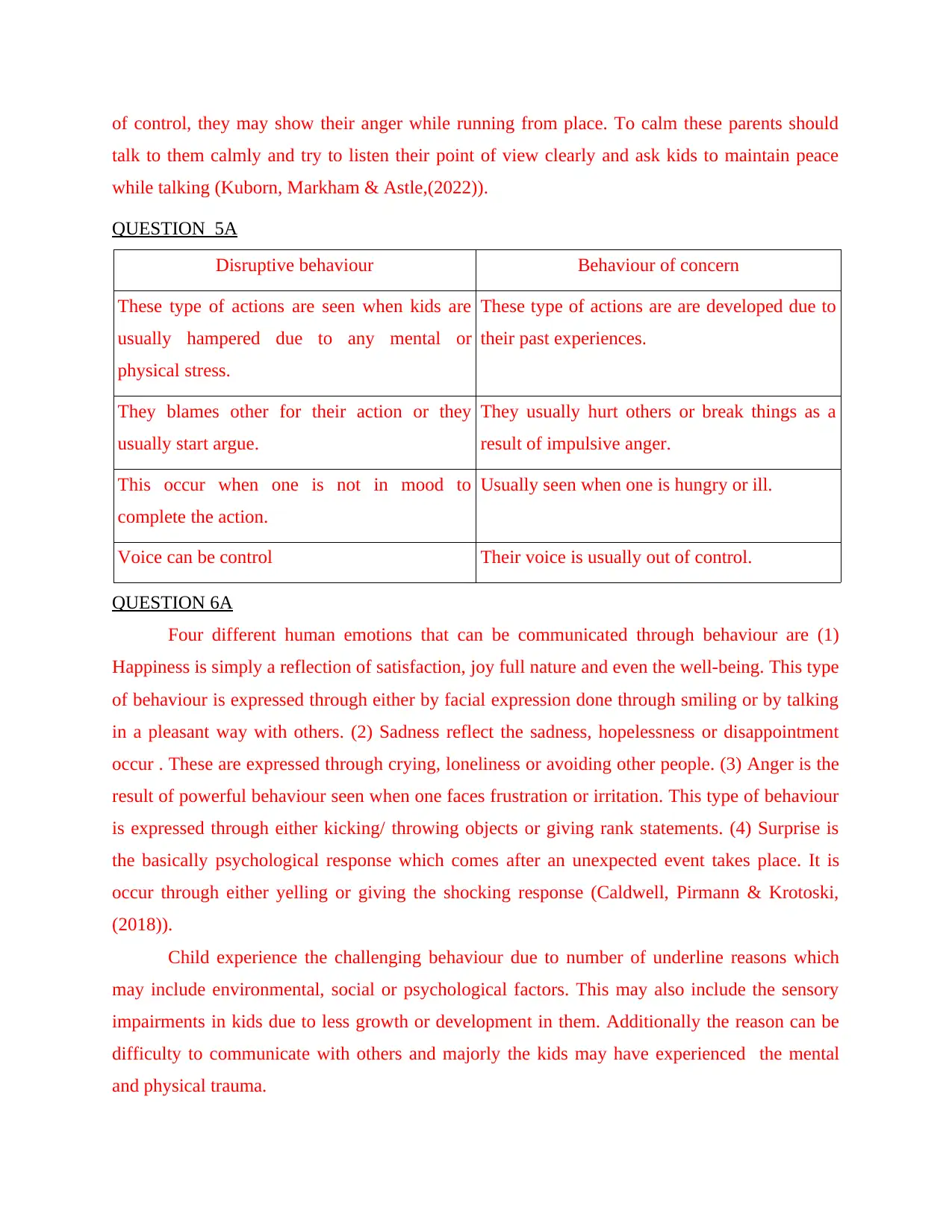
of control, they may show their anger while running from place. To calm these parents should
talk to them calmly and try to listen their point of view clearly and ask kids to maintain peace
while talking (Kuborn, Markham & Astle,(2022)).
QUESTION 5A
Disruptive behaviour Behaviour of concern
These type of actions are seen when kids are
usually hampered due to any mental or
physical stress.
These type of actions are are developed due to
their past experiences.
They blames other for their action or they
usually start argue.
They usually hurt others or break things as a
result of impulsive anger.
This occur when one is not in mood to
complete the action.
Usually seen when one is hungry or ill.
Voice can be control Their voice is usually out of control.
QUESTION 6A
Four different human emotions that can be communicated through behaviour are (1)
Happiness is simply a reflection of satisfaction, joy full nature and even the well-being. This type
of behaviour is expressed through either by facial expression done through smiling or by talking
in a pleasant way with others. (2) Sadness reflect the sadness, hopelessness or disappointment
occur . These are expressed through crying, loneliness or avoiding other people. (3) Anger is the
result of powerful behaviour seen when one faces frustration or irritation. This type of behaviour
is expressed through either kicking/ throwing objects or giving rank statements. (4) Surprise is
the basically psychological response which comes after an unexpected event takes place. It is
occur through either yelling or giving the shocking response (Caldwell, Pirmann & Krotoski,
(2018)).
Child experience the challenging behaviour due to number of underline reasons which
may include environmental, social or psychological factors. This may also include the sensory
impairments in kids due to less growth or development in them. Additionally the reason can be
difficulty to communicate with others and majorly the kids may have experienced the mental
and physical trauma.
talk to them calmly and try to listen their point of view clearly and ask kids to maintain peace
while talking (Kuborn, Markham & Astle,(2022)).
QUESTION 5A
Disruptive behaviour Behaviour of concern
These type of actions are seen when kids are
usually hampered due to any mental or
physical stress.
These type of actions are are developed due to
their past experiences.
They blames other for their action or they
usually start argue.
They usually hurt others or break things as a
result of impulsive anger.
This occur when one is not in mood to
complete the action.
Usually seen when one is hungry or ill.
Voice can be control Their voice is usually out of control.
QUESTION 6A
Four different human emotions that can be communicated through behaviour are (1)
Happiness is simply a reflection of satisfaction, joy full nature and even the well-being. This type
of behaviour is expressed through either by facial expression done through smiling or by talking
in a pleasant way with others. (2) Sadness reflect the sadness, hopelessness or disappointment
occur . These are expressed through crying, loneliness or avoiding other people. (3) Anger is the
result of powerful behaviour seen when one faces frustration or irritation. This type of behaviour
is expressed through either kicking/ throwing objects or giving rank statements. (4) Surprise is
the basically psychological response which comes after an unexpected event takes place. It is
occur through either yelling or giving the shocking response (Caldwell, Pirmann & Krotoski,
(2018)).
Child experience the challenging behaviour due to number of underline reasons which
may include environmental, social or psychological factors. This may also include the sensory
impairments in kids due to less growth or development in them. Additionally the reason can be
difficulty to communicate with others and majorly the kids may have experienced the mental
and physical trauma.
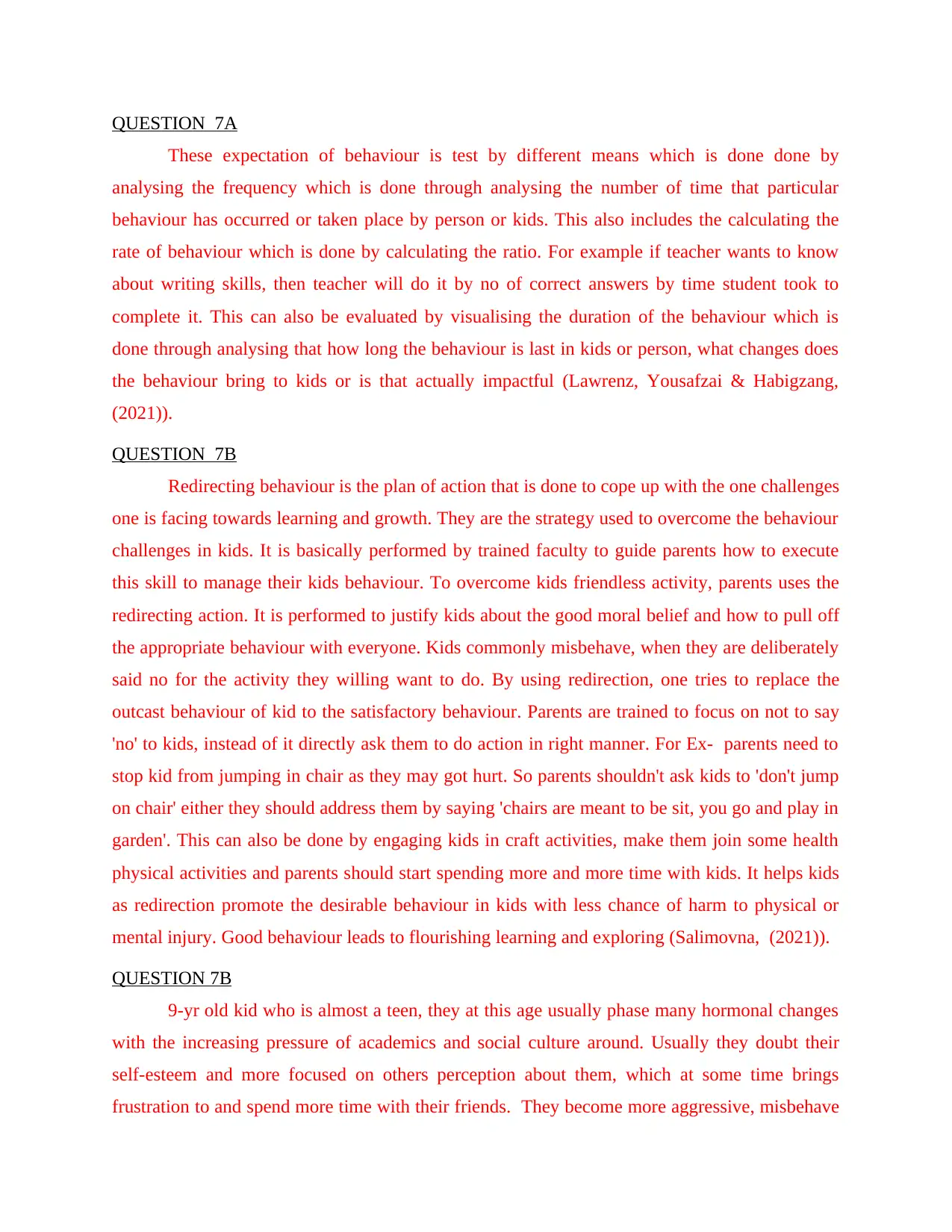
QUESTION 7A
These expectation of behaviour is test by different means which is done done by
analysing the frequency which is done through analysing the number of time that particular
behaviour has occurred or taken place by person or kids. This also includes the calculating the
rate of behaviour which is done by calculating the ratio. For example if teacher wants to know
about writing skills, then teacher will do it by no of correct answers by time student took to
complete it. This can also be evaluated by visualising the duration of the behaviour which is
done through analysing that how long the behaviour is last in kids or person, what changes does
the behaviour bring to kids or is that actually impactful (Lawrenz, Yousafzai & Habigzang,
(2021)).
QUESTION 7B
Redirecting behaviour is the plan of action that is done to cope up with the one challenges
one is facing towards learning and growth. They are the strategy used to overcome the behaviour
challenges in kids. It is basically performed by trained faculty to guide parents how to execute
this skill to manage their kids behaviour. To overcome kids friendless activity, parents uses the
redirecting action. It is performed to justify kids about the good moral belief and how to pull off
the appropriate behaviour with everyone. Kids commonly misbehave, when they are deliberately
said no for the activity they willing want to do. By using redirection, one tries to replace the
outcast behaviour of kid to the satisfactory behaviour. Parents are trained to focus on not to say
'no' to kids, instead of it directly ask them to do action in right manner. For Ex- parents need to
stop kid from jumping in chair as they may got hurt. So parents shouldn't ask kids to 'don't jump
on chair' either they should address them by saying 'chairs are meant to be sit, you go and play in
garden'. This can also be done by engaging kids in craft activities, make them join some health
physical activities and parents should start spending more and more time with kids. It helps kids
as redirection promote the desirable behaviour in kids with less chance of harm to physical or
mental injury. Good behaviour leads to flourishing learning and exploring (Salimovna, (2021)).
QUESTION 7B
9-yr old kid who is almost a teen, they at this age usually phase many hormonal changes
with the increasing pressure of academics and social culture around. Usually they doubt their
self-esteem and more focused on others perception about them, which at some time brings
frustration to and spend more time with their friends. They become more aggressive, misbehave
These expectation of behaviour is test by different means which is done done by
analysing the frequency which is done through analysing the number of time that particular
behaviour has occurred or taken place by person or kids. This also includes the calculating the
rate of behaviour which is done by calculating the ratio. For example if teacher wants to know
about writing skills, then teacher will do it by no of correct answers by time student took to
complete it. This can also be evaluated by visualising the duration of the behaviour which is
done through analysing that how long the behaviour is last in kids or person, what changes does
the behaviour bring to kids or is that actually impactful (Lawrenz, Yousafzai & Habigzang,
(2021)).
QUESTION 7B
Redirecting behaviour is the plan of action that is done to cope up with the one challenges
one is facing towards learning and growth. They are the strategy used to overcome the behaviour
challenges in kids. It is basically performed by trained faculty to guide parents how to execute
this skill to manage their kids behaviour. To overcome kids friendless activity, parents uses the
redirecting action. It is performed to justify kids about the good moral belief and how to pull off
the appropriate behaviour with everyone. Kids commonly misbehave, when they are deliberately
said no for the activity they willing want to do. By using redirection, one tries to replace the
outcast behaviour of kid to the satisfactory behaviour. Parents are trained to focus on not to say
'no' to kids, instead of it directly ask them to do action in right manner. For Ex- parents need to
stop kid from jumping in chair as they may got hurt. So parents shouldn't ask kids to 'don't jump
on chair' either they should address them by saying 'chairs are meant to be sit, you go and play in
garden'. This can also be done by engaging kids in craft activities, make them join some health
physical activities and parents should start spending more and more time with kids. It helps kids
as redirection promote the desirable behaviour in kids with less chance of harm to physical or
mental injury. Good behaviour leads to flourishing learning and exploring (Salimovna, (2021)).
QUESTION 7B
9-yr old kid who is almost a teen, they at this age usually phase many hormonal changes
with the increasing pressure of academics and social culture around. Usually they doubt their
self-esteem and more focused on others perception about them, which at some time brings
frustration to and spend more time with their friends. They become more aggressive, misbehave
⊘ This is a preview!⊘
Do you want full access?
Subscribe today to unlock all pages.

Trusted by 1+ million students worldwide
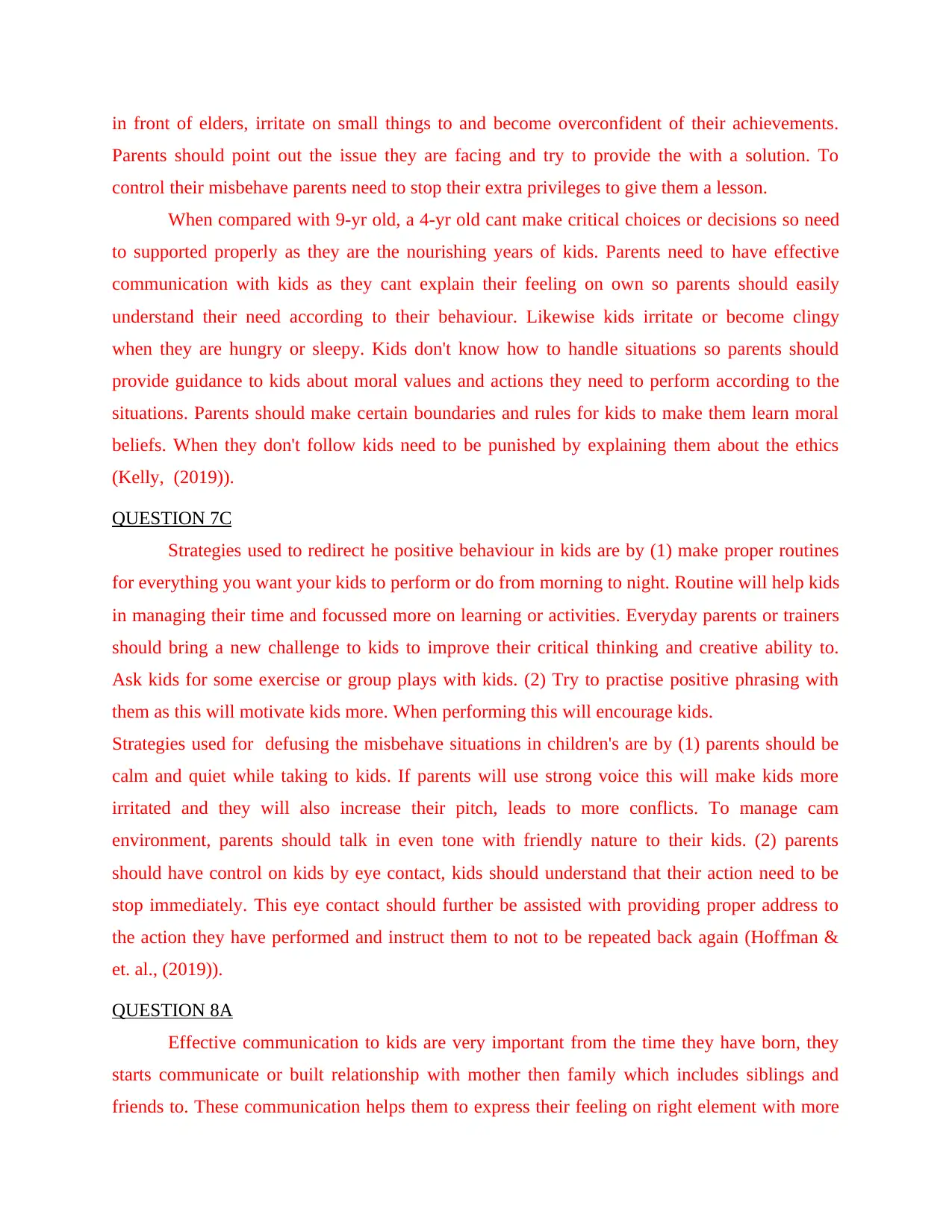
in front of elders, irritate on small things to and become overconfident of their achievements.
Parents should point out the issue they are facing and try to provide the with a solution. To
control their misbehave parents need to stop their extra privileges to give them a lesson.
When compared with 9-yr old, a 4-yr old cant make critical choices or decisions so need
to supported properly as they are the nourishing years of kids. Parents need to have effective
communication with kids as they cant explain their feeling on own so parents should easily
understand their need according to their behaviour. Likewise kids irritate or become clingy
when they are hungry or sleepy. Kids don't know how to handle situations so parents should
provide guidance to kids about moral values and actions they need to perform according to the
situations. Parents should make certain boundaries and rules for kids to make them learn moral
beliefs. When they don't follow kids need to be punished by explaining them about the ethics
(Kelly, (2019)).
QUESTION 7C
Strategies used to redirect he positive behaviour in kids are by (1) make proper routines
for everything you want your kids to perform or do from morning to night. Routine will help kids
in managing their time and focussed more on learning or activities. Everyday parents or trainers
should bring a new challenge to kids to improve their critical thinking and creative ability to.
Ask kids for some exercise or group plays with kids. (2) Try to practise positive phrasing with
them as this will motivate kids more. When performing this will encourage kids.
Strategies used for defusing the misbehave situations in children's are by (1) parents should be
calm and quiet while taking to kids. If parents will use strong voice this will make kids more
irritated and they will also increase their pitch, leads to more conflicts. To manage cam
environment, parents should talk in even tone with friendly nature to their kids. (2) parents
should have control on kids by eye contact, kids should understand that their action need to be
stop immediately. This eye contact should further be assisted with providing proper address to
the action they have performed and instruct them to not to be repeated back again (Hoffman &
et. al., (2019)).
QUESTION 8A
Effective communication to kids are very important from the time they have born, they
starts communicate or built relationship with mother then family which includes siblings and
friends to. These communication helps them to express their feeling on right element with more
Parents should point out the issue they are facing and try to provide the with a solution. To
control their misbehave parents need to stop their extra privileges to give them a lesson.
When compared with 9-yr old, a 4-yr old cant make critical choices or decisions so need
to supported properly as they are the nourishing years of kids. Parents need to have effective
communication with kids as they cant explain their feeling on own so parents should easily
understand their need according to their behaviour. Likewise kids irritate or become clingy
when they are hungry or sleepy. Kids don't know how to handle situations so parents should
provide guidance to kids about moral values and actions they need to perform according to the
situations. Parents should make certain boundaries and rules for kids to make them learn moral
beliefs. When they don't follow kids need to be punished by explaining them about the ethics
(Kelly, (2019)).
QUESTION 7C
Strategies used to redirect he positive behaviour in kids are by (1) make proper routines
for everything you want your kids to perform or do from morning to night. Routine will help kids
in managing their time and focussed more on learning or activities. Everyday parents or trainers
should bring a new challenge to kids to improve their critical thinking and creative ability to.
Ask kids for some exercise or group plays with kids. (2) Try to practise positive phrasing with
them as this will motivate kids more. When performing this will encourage kids.
Strategies used for defusing the misbehave situations in children's are by (1) parents should be
calm and quiet while taking to kids. If parents will use strong voice this will make kids more
irritated and they will also increase their pitch, leads to more conflicts. To manage cam
environment, parents should talk in even tone with friendly nature to their kids. (2) parents
should have control on kids by eye contact, kids should understand that their action need to be
stop immediately. This eye contact should further be assisted with providing proper address to
the action they have performed and instruct them to not to be repeated back again (Hoffman &
et. al., (2019)).
QUESTION 8A
Effective communication to kids are very important from the time they have born, they
starts communicate or built relationship with mother then family which includes siblings and
friends to. These communication helps them to express their feeling on right element with more
Paraphrase This Document
Need a fresh take? Get an instant paraphrase of this document with our AI Paraphraser
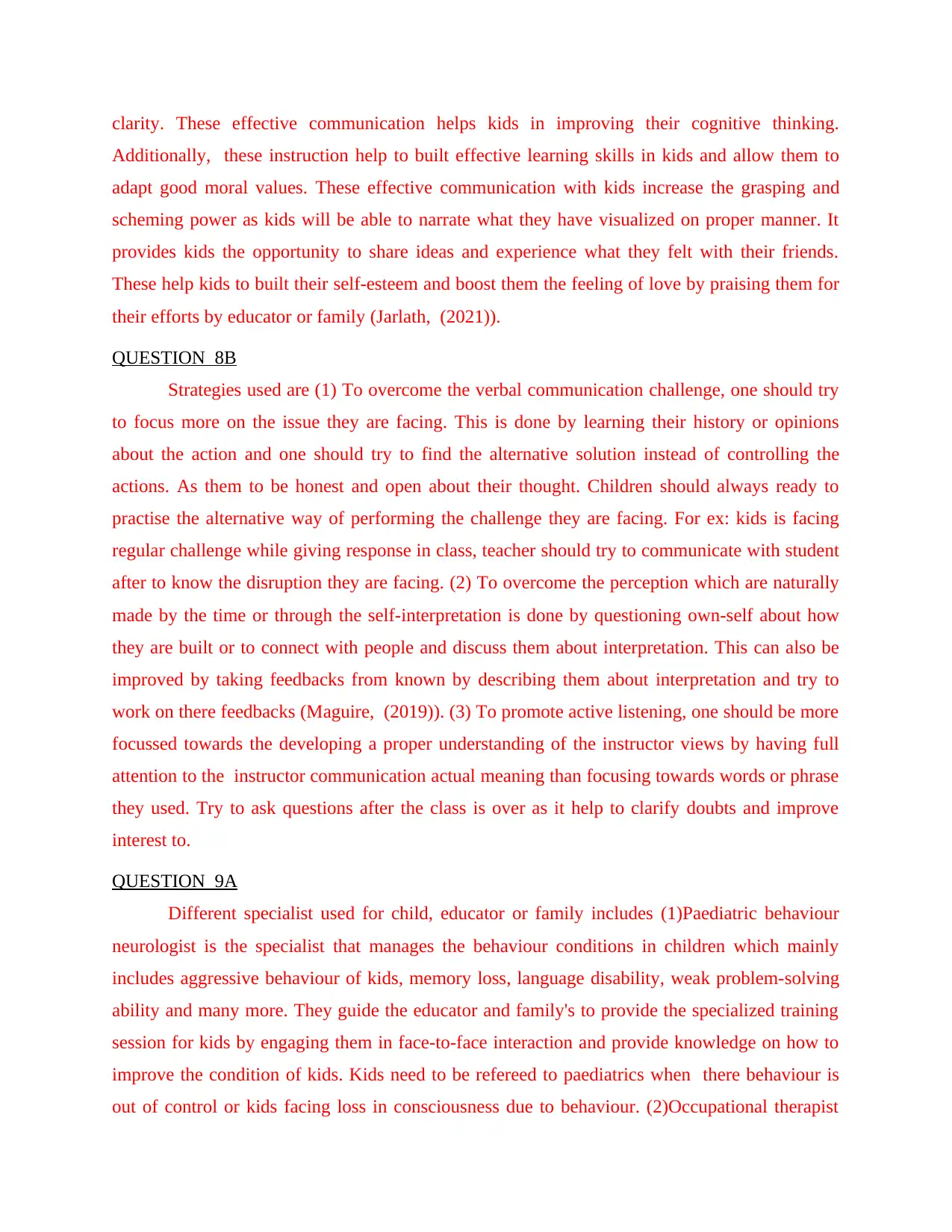
clarity. These effective communication helps kids in improving their cognitive thinking.
Additionally, these instruction help to built effective learning skills in kids and allow them to
adapt good moral values. These effective communication with kids increase the grasping and
scheming power as kids will be able to narrate what they have visualized on proper manner. It
provides kids the opportunity to share ideas and experience what they felt with their friends.
These help kids to built their self-esteem and boost them the feeling of love by praising them for
their efforts by educator or family (Jarlath, (2021)).
QUESTION 8B
Strategies used are (1) To overcome the verbal communication challenge, one should try
to focus more on the issue they are facing. This is done by learning their history or opinions
about the action and one should try to find the alternative solution instead of controlling the
actions. As them to be honest and open about their thought. Children should always ready to
practise the alternative way of performing the challenge they are facing. For ex: kids is facing
regular challenge while giving response in class, teacher should try to communicate with student
after to know the disruption they are facing. (2) To overcome the perception which are naturally
made by the time or through the self-interpretation is done by questioning own-self about how
they are built or to connect with people and discuss them about interpretation. This can also be
improved by taking feedbacks from known by describing them about interpretation and try to
work on there feedbacks (Maguire, (2019)). (3) To promote active listening, one should be more
focussed towards the developing a proper understanding of the instructor views by having full
attention to the instructor communication actual meaning than focusing towards words or phrase
they used. Try to ask questions after the class is over as it help to clarify doubts and improve
interest to.
QUESTION 9A
Different specialist used for child, educator or family includes (1)Paediatric behaviour
neurologist is the specialist that manages the behaviour conditions in children which mainly
includes aggressive behaviour of kids, memory loss, language disability, weak problem-solving
ability and many more. They guide the educator and family's to provide the specialized training
session for kids by engaging them in face-to-face interaction and provide knowledge on how to
improve the condition of kids. Kids need to be refereed to paediatrics when there behaviour is
out of control or kids facing loss in consciousness due to behaviour. (2)Occupational therapist
Additionally, these instruction help to built effective learning skills in kids and allow them to
adapt good moral values. These effective communication with kids increase the grasping and
scheming power as kids will be able to narrate what they have visualized on proper manner. It
provides kids the opportunity to share ideas and experience what they felt with their friends.
These help kids to built their self-esteem and boost them the feeling of love by praising them for
their efforts by educator or family (Jarlath, (2021)).
QUESTION 8B
Strategies used are (1) To overcome the verbal communication challenge, one should try
to focus more on the issue they are facing. This is done by learning their history or opinions
about the action and one should try to find the alternative solution instead of controlling the
actions. As them to be honest and open about their thought. Children should always ready to
practise the alternative way of performing the challenge they are facing. For ex: kids is facing
regular challenge while giving response in class, teacher should try to communicate with student
after to know the disruption they are facing. (2) To overcome the perception which are naturally
made by the time or through the self-interpretation is done by questioning own-self about how
they are built or to connect with people and discuss them about interpretation. This can also be
improved by taking feedbacks from known by describing them about interpretation and try to
work on there feedbacks (Maguire, (2019)). (3) To promote active listening, one should be more
focussed towards the developing a proper understanding of the instructor views by having full
attention to the instructor communication actual meaning than focusing towards words or phrase
they used. Try to ask questions after the class is over as it help to clarify doubts and improve
interest to.
QUESTION 9A
Different specialist used for child, educator or family includes (1)Paediatric behaviour
neurologist is the specialist that manages the behaviour conditions in children which mainly
includes aggressive behaviour of kids, memory loss, language disability, weak problem-solving
ability and many more. They guide the educator and family's to provide the specialized training
session for kids by engaging them in face-to-face interaction and provide knowledge on how to
improve the condition of kids. Kids need to be refereed to paediatrics when there behaviour is
out of control or kids facing loss in consciousness due to behaviour. (2)Occupational therapist
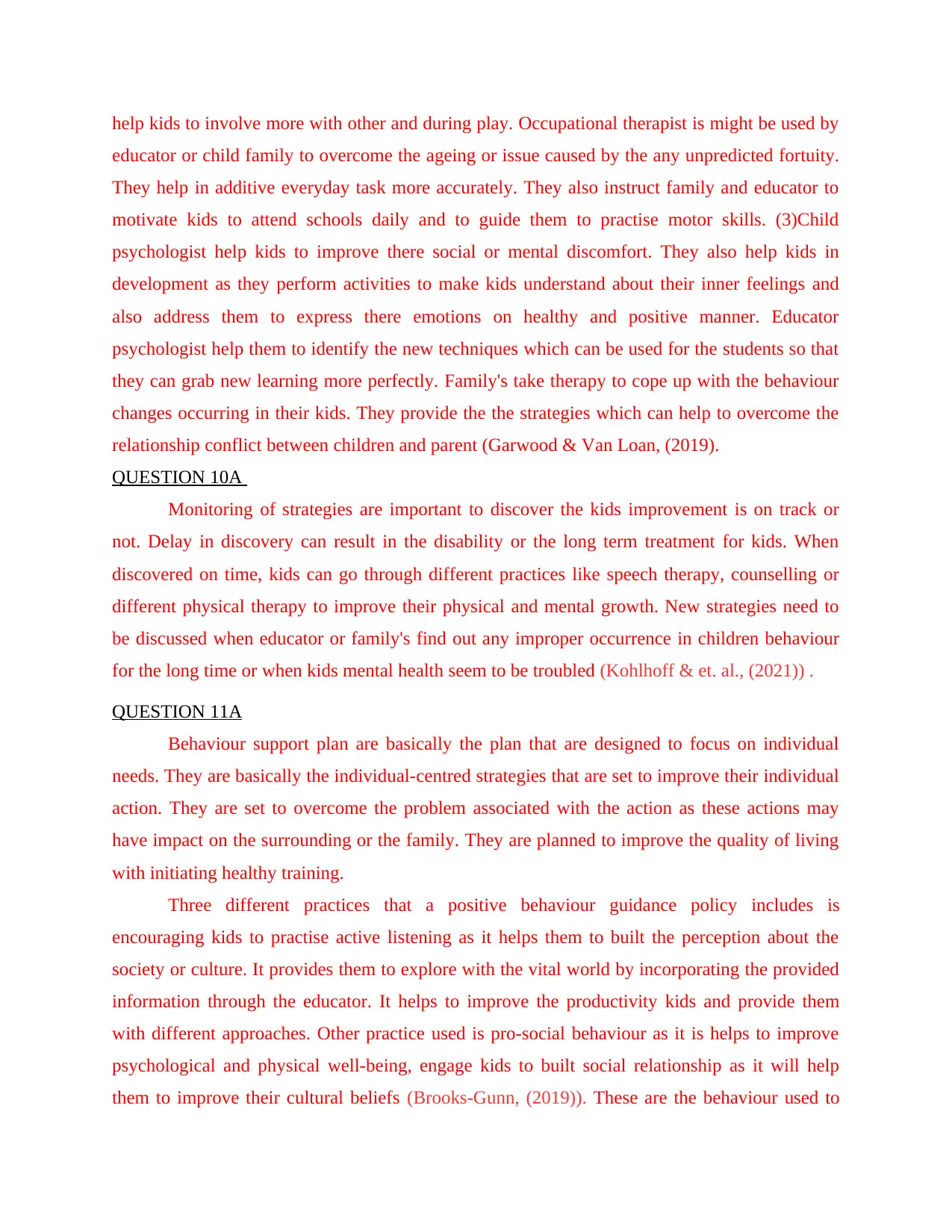
help kids to involve more with other and during play. Occupational therapist is might be used by
educator or child family to overcome the ageing or issue caused by the any unpredicted fortuity.
They help in additive everyday task more accurately. They also instruct family and educator to
motivate kids to attend schools daily and to guide them to practise motor skills. (3)Child
psychologist help kids to improve there social or mental discomfort. They also help kids in
development as they perform activities to make kids understand about their inner feelings and
also address them to express there emotions on healthy and positive manner. Educator
psychologist help them to identify the new techniques which can be used for the students so that
they can grab new learning more perfectly. Family's take therapy to cope up with the behaviour
changes occurring in their kids. They provide the the strategies which can help to overcome the
relationship conflict between children and parent (Garwood & Van Loan, (2019).
QUESTION 10A
Monitoring of strategies are important to discover the kids improvement is on track or
not. Delay in discovery can result in the disability or the long term treatment for kids. When
discovered on time, kids can go through different practices like speech therapy, counselling or
different physical therapy to improve their physical and mental growth. New strategies need to
be discussed when educator or family's find out any improper occurrence in children behaviour
for the long time or when kids mental health seem to be troubled (Kohlhoff & et. al., (2021)) .
QUESTION 11A
Behaviour support plan are basically the plan that are designed to focus on individual
needs. They are basically the individual-centred strategies that are set to improve their individual
action. They are set to overcome the problem associated with the action as these actions may
have impact on the surrounding or the family. They are planned to improve the quality of living
with initiating healthy training.
Three different practices that a positive behaviour guidance policy includes is
encouraging kids to practise active listening as it helps them to built the perception about the
society or culture. It provides them to explore with the vital world by incorporating the provided
information through the educator. It helps to improve the productivity kids and provide them
with different approaches. Other practice used is pro-social behaviour as it is helps to improve
psychological and physical well-being, engage kids to built social relationship as it will help
them to improve their cultural beliefs (Brooks-Gunn, (2019)). These are the behaviour used to
educator or child family to overcome the ageing or issue caused by the any unpredicted fortuity.
They help in additive everyday task more accurately. They also instruct family and educator to
motivate kids to attend schools daily and to guide them to practise motor skills. (3)Child
psychologist help kids to improve there social or mental discomfort. They also help kids in
development as they perform activities to make kids understand about their inner feelings and
also address them to express there emotions on healthy and positive manner. Educator
psychologist help them to identify the new techniques which can be used for the students so that
they can grab new learning more perfectly. Family's take therapy to cope up with the behaviour
changes occurring in their kids. They provide the the strategies which can help to overcome the
relationship conflict between children and parent (Garwood & Van Loan, (2019).
QUESTION 10A
Monitoring of strategies are important to discover the kids improvement is on track or
not. Delay in discovery can result in the disability or the long term treatment for kids. When
discovered on time, kids can go through different practices like speech therapy, counselling or
different physical therapy to improve their physical and mental growth. New strategies need to
be discussed when educator or family's find out any improper occurrence in children behaviour
for the long time or when kids mental health seem to be troubled (Kohlhoff & et. al., (2021)) .
QUESTION 11A
Behaviour support plan are basically the plan that are designed to focus on individual
needs. They are basically the individual-centred strategies that are set to improve their individual
action. They are set to overcome the problem associated with the action as these actions may
have impact on the surrounding or the family. They are planned to improve the quality of living
with initiating healthy training.
Three different practices that a positive behaviour guidance policy includes is
encouraging kids to practise active listening as it helps them to built the perception about the
society or culture. It provides them to explore with the vital world by incorporating the provided
information through the educator. It helps to improve the productivity kids and provide them
with different approaches. Other practice used is pro-social behaviour as it is helps to improve
psychological and physical well-being, engage kids to built social relationship as it will help
them to improve their cultural beliefs (Brooks-Gunn, (2019)). These are the behaviour used to
⊘ This is a preview!⊘
Do you want full access?
Subscribe today to unlock all pages.

Trusted by 1+ million students worldwide
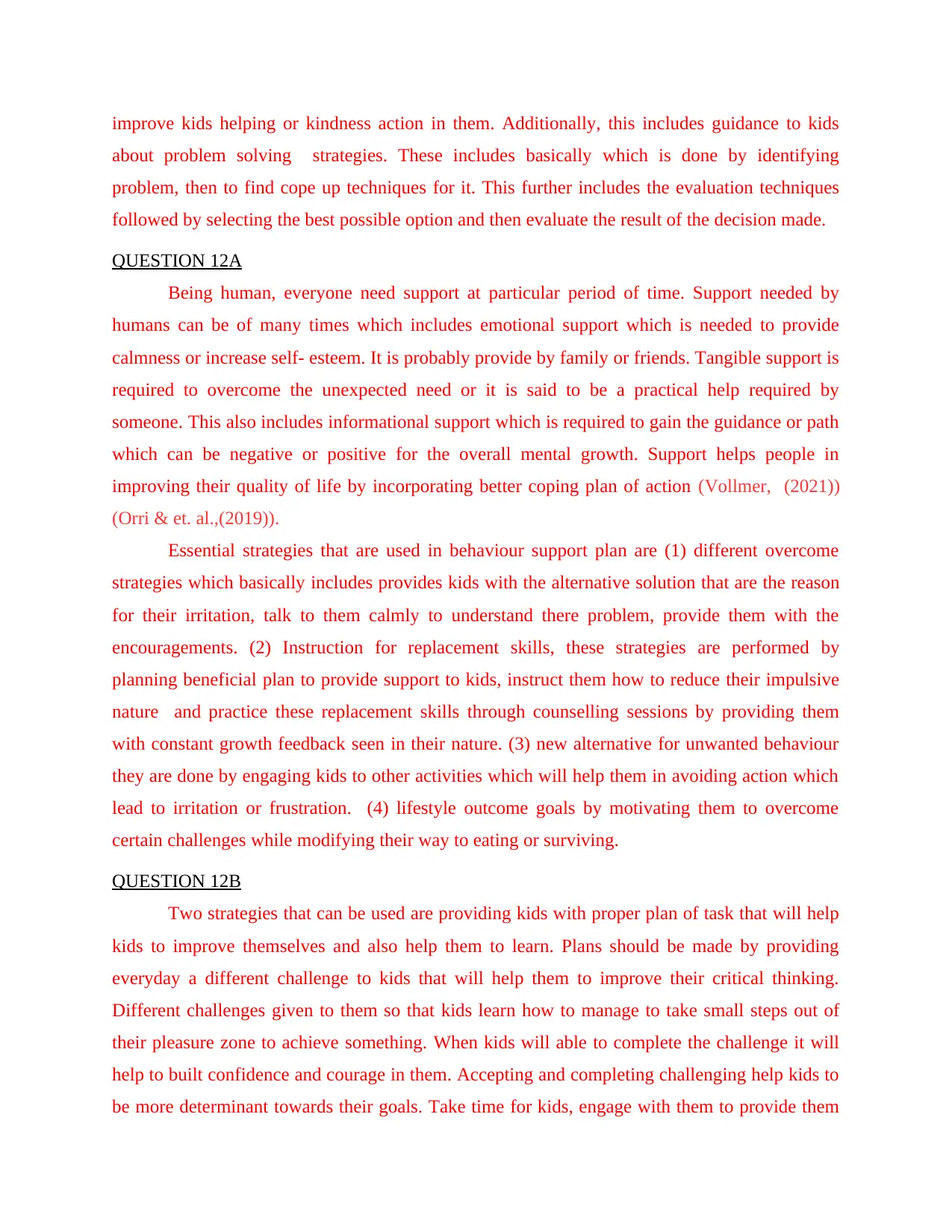
improve kids helping or kindness action in them. Additionally, this includes guidance to kids
about problem solving strategies. These includes basically which is done by identifying
problem, then to find cope up techniques for it. This further includes the evaluation techniques
followed by selecting the best possible option and then evaluate the result of the decision made.
QUESTION 12A
Being human, everyone need support at particular period of time. Support needed by
humans can be of many times which includes emotional support which is needed to provide
calmness or increase self- esteem. It is probably provide by family or friends. Tangible support is
required to overcome the unexpected need or it is said to be a practical help required by
someone. This also includes informational support which is required to gain the guidance or path
which can be negative or positive for the overall mental growth. Support helps people in
improving their quality of life by incorporating better coping plan of action (Vollmer, (2021))
(Orri & et. al.,(2019)).
Essential strategies that are used in behaviour support plan are (1) different overcome
strategies which basically includes provides kids with the alternative solution that are the reason
for their irritation, talk to them calmly to understand there problem, provide them with the
encouragements. (2) Instruction for replacement skills, these strategies are performed by
planning beneficial plan to provide support to kids, instruct them how to reduce their impulsive
nature and practice these replacement skills through counselling sessions by providing them
with constant growth feedback seen in their nature. (3) new alternative for unwanted behaviour
they are done by engaging kids to other activities which will help them in avoiding action which
lead to irritation or frustration. (4) lifestyle outcome goals by motivating them to overcome
certain challenges while modifying their way to eating or surviving.
QUESTION 12B
Two strategies that can be used are providing kids with proper plan of task that will help
kids to improve themselves and also help them to learn. Plans should be made by providing
everyday a different challenge to kids that will help them to improve their critical thinking.
Different challenges given to them so that kids learn how to manage to take small steps out of
their pleasure zone to achieve something. When kids will able to complete the challenge it will
help to built confidence and courage in them. Accepting and completing challenging help kids to
be more determinant towards their goals. Take time for kids, engage with them to provide them
about problem solving strategies. These includes basically which is done by identifying
problem, then to find cope up techniques for it. This further includes the evaluation techniques
followed by selecting the best possible option and then evaluate the result of the decision made.
QUESTION 12A
Being human, everyone need support at particular period of time. Support needed by
humans can be of many times which includes emotional support which is needed to provide
calmness or increase self- esteem. It is probably provide by family or friends. Tangible support is
required to overcome the unexpected need or it is said to be a practical help required by
someone. This also includes informational support which is required to gain the guidance or path
which can be negative or positive for the overall mental growth. Support helps people in
improving their quality of life by incorporating better coping plan of action (Vollmer, (2021))
(Orri & et. al.,(2019)).
Essential strategies that are used in behaviour support plan are (1) different overcome
strategies which basically includes provides kids with the alternative solution that are the reason
for their irritation, talk to them calmly to understand there problem, provide them with the
encouragements. (2) Instruction for replacement skills, these strategies are performed by
planning beneficial plan to provide support to kids, instruct them how to reduce their impulsive
nature and practice these replacement skills through counselling sessions by providing them
with constant growth feedback seen in their nature. (3) new alternative for unwanted behaviour
they are done by engaging kids to other activities which will help them in avoiding action which
lead to irritation or frustration. (4) lifestyle outcome goals by motivating them to overcome
certain challenges while modifying their way to eating or surviving.
QUESTION 12B
Two strategies that can be used are providing kids with proper plan of task that will help
kids to improve themselves and also help them to learn. Plans should be made by providing
everyday a different challenge to kids that will help them to improve their critical thinking.
Different challenges given to them so that kids learn how to manage to take small steps out of
their pleasure zone to achieve something. When kids will able to complete the challenge it will
help to built confidence and courage in them. Accepting and completing challenging help kids to
be more determinant towards their goals. Take time for kids, engage with them to provide them
Paraphrase This Document
Need a fresh take? Get an instant paraphrase of this document with our AI Paraphraser
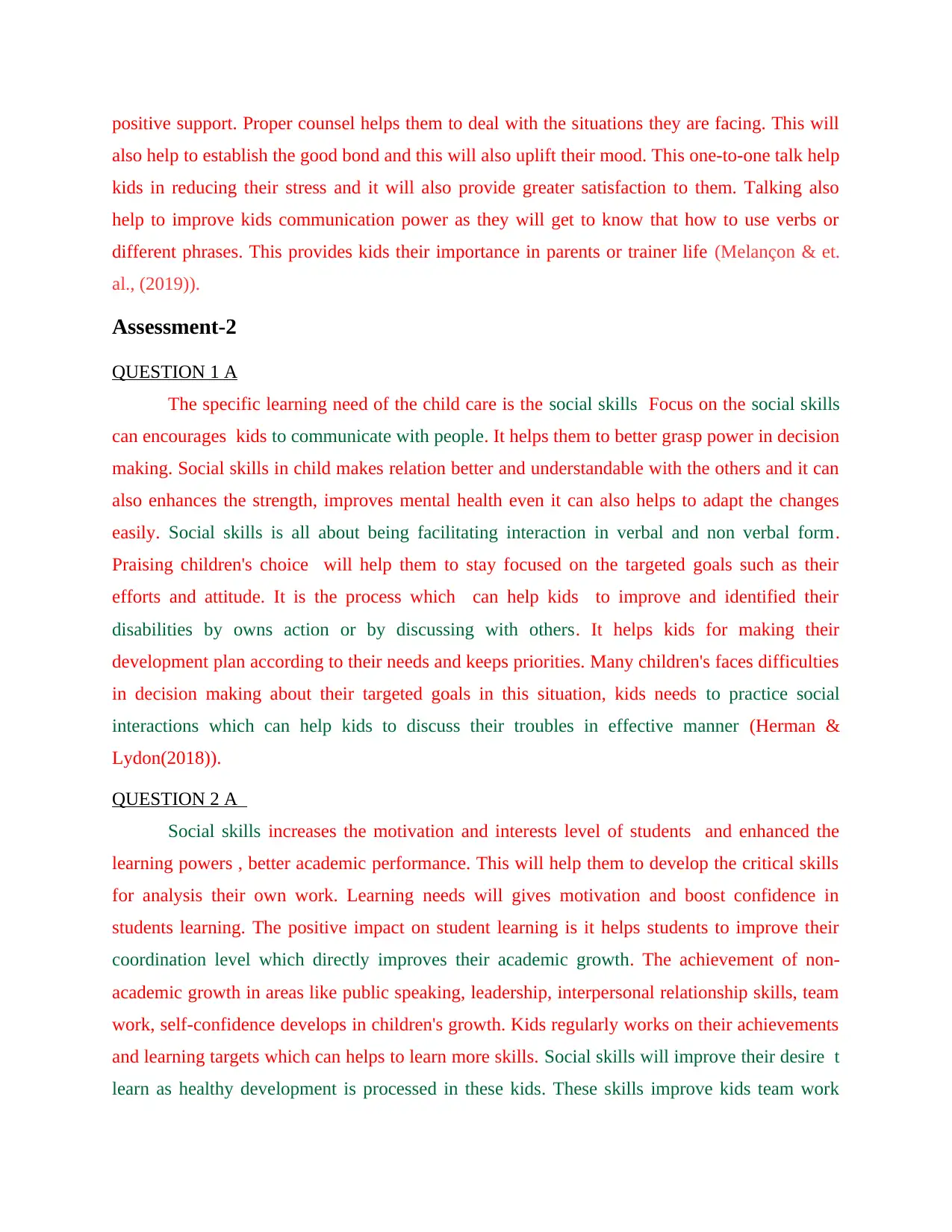
positive support. Proper counsel helps them to deal with the situations they are facing. This will
also help to establish the good bond and this will also uplift their mood. This one-to-one talk help
kids in reducing their stress and it will also provide greater satisfaction to them. Talking also
help to improve kids communication power as they will get to know that how to use verbs or
different phrases. This provides kids their importance in parents or trainer life (Melançon & et.
al., (2019)).
Assessment-2
QUESTION 1 A
The specific learning need of the child care is the social skills Focus on the social skills
can encourages kids to communicate with people. It helps them to better grasp power in decision
making. Social skills in child makes relation better and understandable with the others and it can
also enhances the strength, improves mental health even it can also helps to adapt the changes
easily. Social skills is all about being facilitating interaction in verbal and non verbal form.
Praising children's choice will help them to stay focused on the targeted goals such as their
efforts and attitude. It is the process which can help kids to improve and identified their
disabilities by owns action or by discussing with others. It helps kids for making their
development plan according to their needs and keeps priorities. Many children's faces difficulties
in decision making about their targeted goals in this situation, kids needs to practice social
interactions which can help kids to discuss their troubles in effective manner (Herman &
Lydon(2018)).
QUESTION 2 A
Social skills increases the motivation and interests level of students and enhanced the
learning powers , better academic performance. This will help them to develop the critical skills
for analysis their own work. Learning needs will gives motivation and boost confidence in
students learning. The positive impact on student learning is it helps students to improve their
coordination level which directly improves their academic growth. The achievement of non-
academic growth in areas like public speaking, leadership, interpersonal relationship skills, team
work, self-confidence develops in children's growth. Kids regularly works on their achievements
and learning targets which can helps to learn more skills. Social skills will improve their desire t
learn as healthy development is processed in these kids. These skills improve kids team work
also help to establish the good bond and this will also uplift their mood. This one-to-one talk help
kids in reducing their stress and it will also provide greater satisfaction to them. Talking also
help to improve kids communication power as they will get to know that how to use verbs or
different phrases. This provides kids their importance in parents or trainer life (Melançon & et.
al., (2019)).
Assessment-2
QUESTION 1 A
The specific learning need of the child care is the social skills Focus on the social skills
can encourages kids to communicate with people. It helps them to better grasp power in decision
making. Social skills in child makes relation better and understandable with the others and it can
also enhances the strength, improves mental health even it can also helps to adapt the changes
easily. Social skills is all about being facilitating interaction in verbal and non verbal form.
Praising children's choice will help them to stay focused on the targeted goals such as their
efforts and attitude. It is the process which can help kids to improve and identified their
disabilities by owns action or by discussing with others. It helps kids for making their
development plan according to their needs and keeps priorities. Many children's faces difficulties
in decision making about their targeted goals in this situation, kids needs to practice social
interactions which can help kids to discuss their troubles in effective manner (Herman &
Lydon(2018)).
QUESTION 2 A
Social skills increases the motivation and interests level of students and enhanced the
learning powers , better academic performance. This will help them to develop the critical skills
for analysis their own work. Learning needs will gives motivation and boost confidence in
students learning. The positive impact on student learning is it helps students to improve their
coordination level which directly improves their academic growth. The achievement of non-
academic growth in areas like public speaking, leadership, interpersonal relationship skills, team
work, self-confidence develops in children's growth. Kids regularly works on their achievements
and learning targets which can helps to learn more skills. Social skills will improve their desire t
learn as healthy development is processed in these kids. These skills improve kids team work

potency which significantly related to their active listening skill. Being a successful learner will
help in development of cognitive abilities such as memory retention, problem solving, decision
making and better concentration power (Hess & Pollmann-Schult (2020)).
QUESTION 3A
The educator should rectify the needs of an individual student and implement strategies
that will help in better learning and also enable the educator to give their personal attention to the
child with low cognitive ability. A social skills leads student to relax, remember and focus on the
absorb information as they learn. Children's are ready to face the experiences and recognize
many new things and get more opportunities for their development. It promotes effective
learning experiences, encourages higher levels of student performance, and motivates students to
practice higher-level critical thinking skills. The social skills enable kids to identify what to
express the feeling they are getting and how to take the appropriate decisions according to the
need. Additionally, these skills teach kids to behave in delectable manner in front of others.
While learning these skills develops the resiliency to face future uncertainty and cope up with the
stressful situations (Sameroff & Seifer (2021)).
QUESTION 4A
There are two methods that are used for observation and data collection are as follows:-
Observing children is most important by using different type of observation methods and data
collection can assist in observing children's interest, skills, abilities and their needs. It provides a
beginning for a child's individual planing and assessment.
Sociogram:- This observation method helps in identifying the children's interaction and
behaviour their friends, relatives and in the society. It helps in analysing children's
preferences of interactive how much they are interact with the other group of children's.
Sociogram is the best observation method that will helps to identified the weak children's
through the data collection and different observation methods.
Work sample :- This observation method identified the individual child talent and
efficacy of doing the work such as their academic skills,painting, writing and reading
skills are recorded by the work sample observation methods. Work sample provides the
basic knowledge of the individual children's. The data collection will help in analysis the
talented students among the other group of children's and the children's having less skills
and cope up and learn the different new skills.
help in development of cognitive abilities such as memory retention, problem solving, decision
making and better concentration power (Hess & Pollmann-Schult (2020)).
QUESTION 3A
The educator should rectify the needs of an individual student and implement strategies
that will help in better learning and also enable the educator to give their personal attention to the
child with low cognitive ability. A social skills leads student to relax, remember and focus on the
absorb information as they learn. Children's are ready to face the experiences and recognize
many new things and get more opportunities for their development. It promotes effective
learning experiences, encourages higher levels of student performance, and motivates students to
practice higher-level critical thinking skills. The social skills enable kids to identify what to
express the feeling they are getting and how to take the appropriate decisions according to the
need. Additionally, these skills teach kids to behave in delectable manner in front of others.
While learning these skills develops the resiliency to face future uncertainty and cope up with the
stressful situations (Sameroff & Seifer (2021)).
QUESTION 4A
There are two methods that are used for observation and data collection are as follows:-
Observing children is most important by using different type of observation methods and data
collection can assist in observing children's interest, skills, abilities and their needs. It provides a
beginning for a child's individual planing and assessment.
Sociogram:- This observation method helps in identifying the children's interaction and
behaviour their friends, relatives and in the society. It helps in analysing children's
preferences of interactive how much they are interact with the other group of children's.
Sociogram is the best observation method that will helps to identified the weak children's
through the data collection and different observation methods.
Work sample :- This observation method identified the individual child talent and
efficacy of doing the work such as their academic skills,painting, writing and reading
skills are recorded by the work sample observation methods. Work sample provides the
basic knowledge of the individual children's. The data collection will help in analysis the
talented students among the other group of children's and the children's having less skills
and cope up and learn the different new skills.
⊘ This is a preview!⊘
Do you want full access?
Subscribe today to unlock all pages.

Trusted by 1+ million students worldwide
1 out of 17
Your All-in-One AI-Powered Toolkit for Academic Success.
+13062052269
info@desklib.com
Available 24*7 on WhatsApp / Email
![[object Object]](/_next/static/media/star-bottom.7253800d.svg)
Unlock your academic potential
Copyright © 2020–2025 A2Z Services. All Rights Reserved. Developed and managed by ZUCOL.